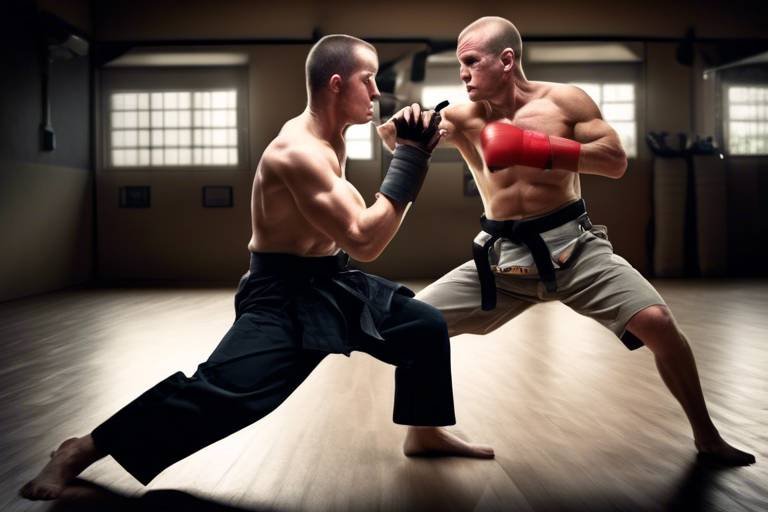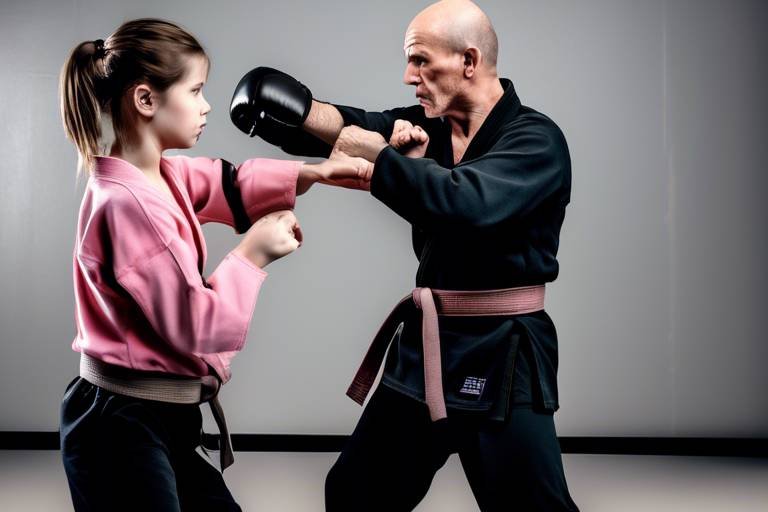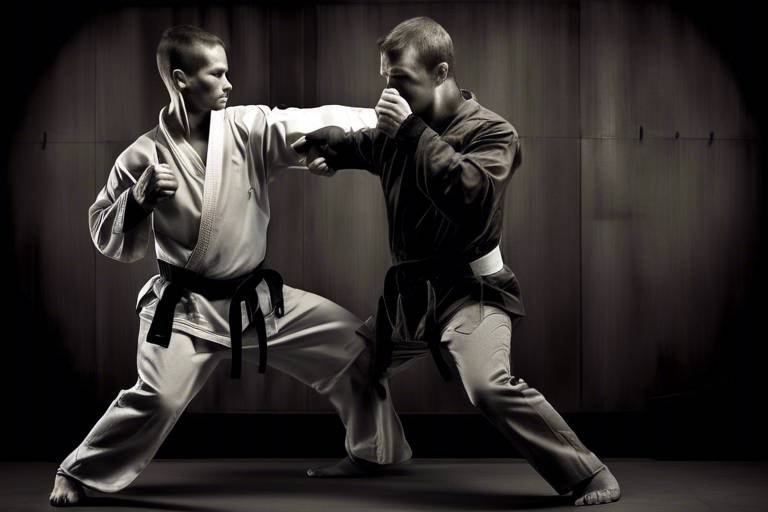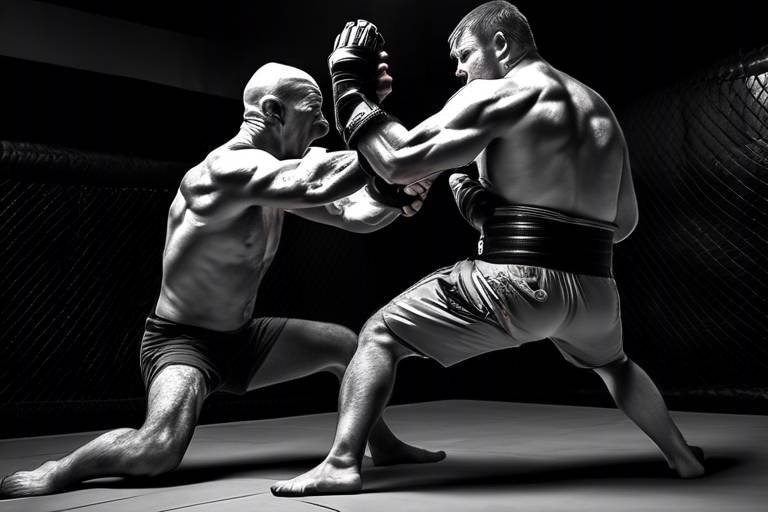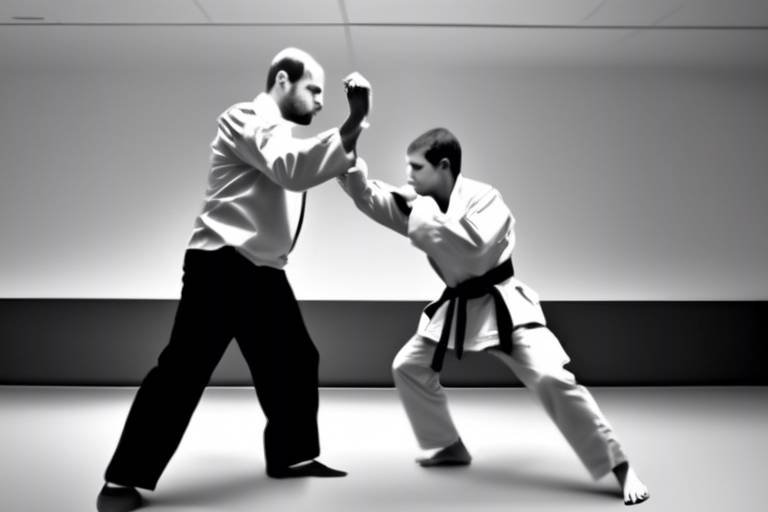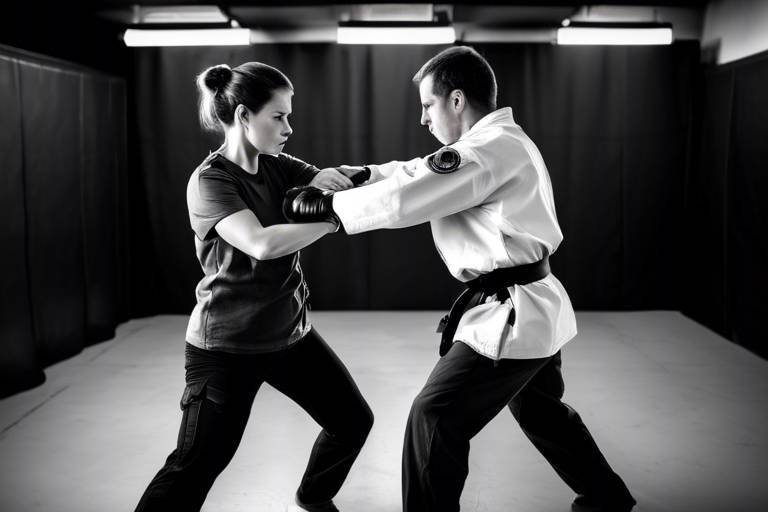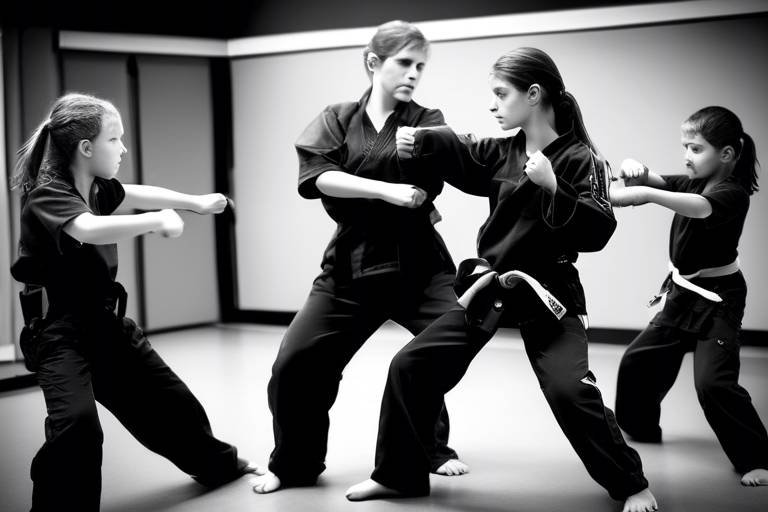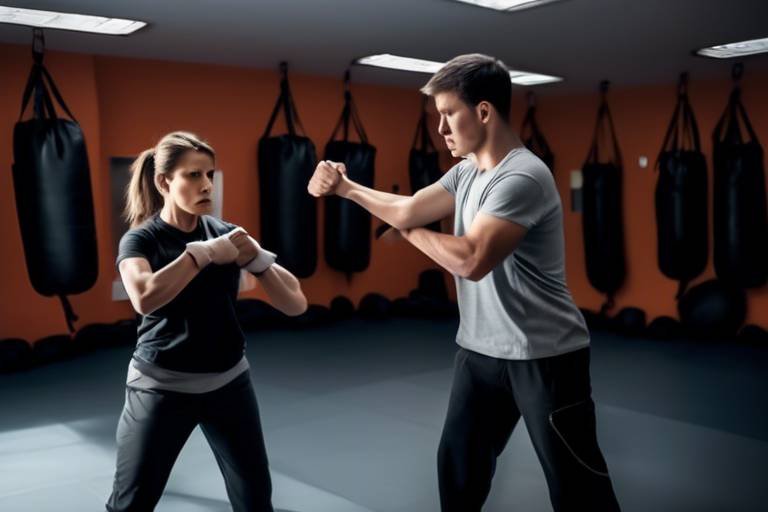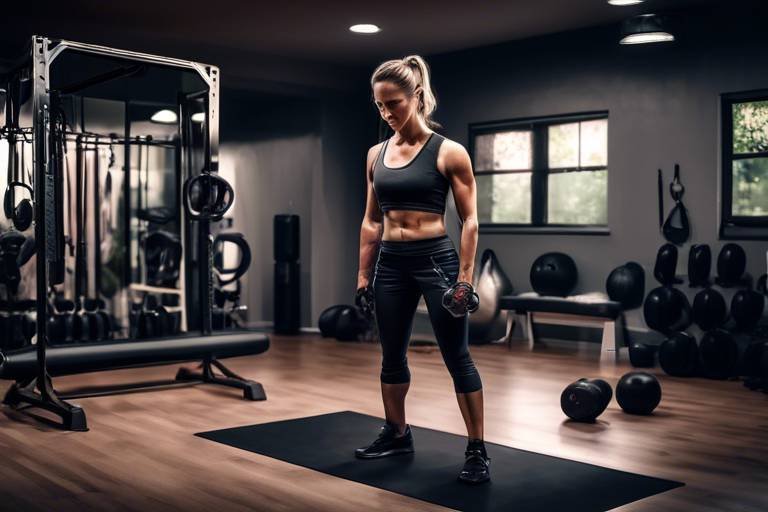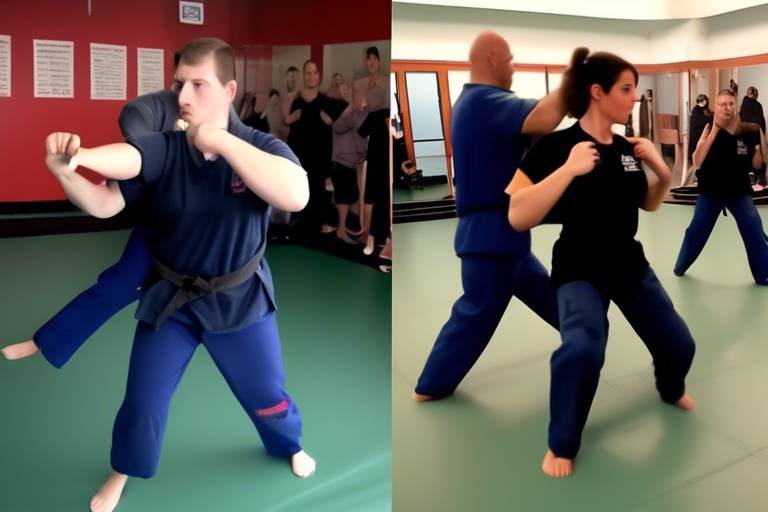How to Leverage Biomechanics in Self-Defense Training
When it comes to self-defense, understanding the principles of biomechanics can be your secret weapon. Imagine being able to harness the natural mechanics of your body to enhance your skills, making every move more effective while reducing the risk of injury. This article dives deep into how you can leverage biomechanics in your self-defense training, transforming your approach and giving you the upper hand in any situation.
Biomechanics is more than just a fancy term; it's the study of the mechanical laws that govern the movement of living organisms. Think of it as the science behind how your body works during physical activities. In the context of self-defense, understanding biomechanics is crucial for optimizing your performance. It allows you to move more efficiently, ensuring that every punch, kick, or block is executed with precision and power. Additionally, by grasping these principles, you can significantly reduce the risk of injuries that often plague martial artists and self-defense practitioners.
Body mechanics refers to the way we move our bodies to perform tasks efficiently. Just like a well-oiled machine, your body has its own unique mechanics that, when mastered, can enhance your self-defense techniques. Imagine trying to lift a heavy box without using your legs; it's not only inefficient but also risky. The same principle applies to self-defense. By understanding your body mechanics, you can improve your overall physical performance, making your movements smoother and more powerful.
Have you ever noticed how some people seem to generate immense power with minimal effort? That's the magic of understanding force generation. In self-defense, knowing how to effectively generate force is crucial. Techniques such as hip rotation, proper stance, and timing play a significant role in maximizing your force output while minimizing energy expenditure. For instance, when you throw a punch, it's not just about the arm; it's about engaging your entire body. By learning the right techniques, you can become a powerhouse of energy, ready to defend yourself effectively.
Angles are everything in self-defense. By positioning your body correctly, you can create leverage that enhances the impact of your techniques. Imagine trying to push a heavy object straight on versus at an angle; the latter is often more effective. In self-defense, using angles can improve your striking and defensive capabilities, allowing you to evade attacks while delivering powerful counterstrikes. Understanding how to leverage angles can give you a strategic advantage in any confrontation.
Weight transfer is another essential component of biomechanics that can significantly enhance your self-defense skills. Maintaining balance and power during movements is crucial, and knowing how to shift your weight properly can make all the difference. For example, when executing a kick or a throw, transferring your weight correctly ensures stability and increases the effectiveness of your technique. By mastering weight transfer, you'll not only improve your performance but also reduce the likelihood of losing your balance during a critical moment.
Incorporating biomechanical principles into your training can significantly reduce the risk of injuries. Self-defense training can be rigorous, and without proper technique, you might find yourself sidelined by strains or sprains. By focusing on safe movement patterns and understanding your body's limits, you can train smarter, not harder. Techniques such as proper warm-ups, cool-downs, and recognizing the signs of fatigue are vital. Remember, the goal is to build your skills without compromising your health.
Now that we've covered the theory, let's talk about practical application. Incorporating biomechanics into your training drills can enhance skill acquisition and prepare you for real-life scenarios. The right drills can help you internalize the principles of biomechanics, making them second nature when you need them the most.
Dynamic movement drills are essential for developing fluidity and adaptability in self-defense situations. These drills focus on incorporating biomechanics to improve your reaction time and agility. Think of it as training your body to respond instinctively, much like a reflex action. The more you practice these movements, the more natural they will become, allowing you to react swiftly and effectively in high-pressure situations.
Partner training exercises are invaluable for real-time application of the techniques you've learned. These exercises allow you to implement biomechanical concepts in paired drills, enhancing your learning experience. Working with a partner not only helps you practice your techniques but also provides immediate feedback, allowing you to refine your skills continuously. It's like having a training buddy who helps you grow stronger and more confident in your abilities.
- What is biomechanics in self-defense? Biomechanics in self-defense refers to understanding the mechanical laws of movement to enhance efficiency, effectiveness, and safety during defensive maneuvers.
- How can I improve my self-defense skills using biomechanics? By mastering body mechanics, force generation techniques, and weight transfer, you can significantly enhance your self-defense skills.
- Are there specific drills to practice biomechanics? Yes, dynamic movement drills and partner training exercises are excellent ways to practice and apply biomechanical principles in self-defense.
- Can biomechanics help prevent injuries in self-defense training? Absolutely! By focusing on safe movement patterns and understanding your body's mechanics, you can reduce the risk of injuries during training.

Understanding Biomechanics
Biomechanics is an intriguing field that merges the principles of mechanics with biological systems, primarily focusing on the movements of living organisms. Imagine your body as a finely tuned machine, where every joint, muscle, and tendon plays a vital role in how you move and react. In the context of self-defense, understanding biomechanics is not just beneficial; it’s essential. It allows practitioners to optimize their performance while minimizing the risk of injury, which is crucial when facing unpredictable situations.
At its core, biomechanics examines how forces interact with the body during motion. This study is particularly significant in self-defense training, where the efficiency of movement can mean the difference between success and failure. By analyzing how our bodies move, we can identify the most effective techniques and strategies for defending ourselves. For instance, consider how a martial artist executes a kick. By applying biomechanical principles, they can maximize the force of their strike while conserving energy, making their movements more fluid and effective.
Understanding biomechanics also helps practitioners to recognize their limitations and strengths. It’s like having a roadmap for your body’s capabilities, allowing you to navigate through various self-defense scenarios with greater confidence. This knowledge enables you to adjust your techniques based on your physical attributes, such as strength, flexibility, and balance. For example, if you know you have a strong upper body, you might focus on techniques that leverage that strength, such as powerful strikes or grappling moves.
Moreover, biomechanics plays a crucial role in injury prevention. Self-defense training can be physically demanding, and without a solid understanding of how to move safely, the risk of injuries increases significantly. By incorporating biomechanical principles into your training regimen, you can develop safer movement patterns that reduce the likelihood of strains, sprains, and other common injuries. This is particularly important for beginners who may not yet have the muscle memory or experience to execute techniques correctly.
To sum it up, biomechanics is the backbone of effective self-defense training. It enhances your ability to perform techniques efficiently, helps you understand your body better, and significantly reduces the risk of injury. By embracing the principles of biomechanics, you are not just training your body; you are training your mind to respond instinctively and efficiently in high-pressure situations. So, the next time you step onto the mat or into a self-defense class, remember that understanding the mechanics of your body can empower you to become a more effective and resilient practitioner.

The Role of Body Mechanics
When it comes to self-defense, understanding body mechanics is like having a secret weapon in your arsenal. Body mechanics refers to how we move our bodies to perform tasks efficiently and effectively, and mastering these movements can significantly enhance your self-defense techniques. Imagine your body as a finely tuned instrument; when you know how to play it right, the music of your movements becomes both powerful and graceful.
In self-defense, every motion counts. Whether you’re throwing a punch, dodging an attack, or executing a kick, the way you position your body can make all the difference. By focusing on the mechanics of your body, you can increase your strength, speed, and agility while minimizing the risk of injury. Think of it as the difference between a well-oiled machine and a rusty old car; the former operates smoothly and efficiently, while the latter struggles to get the job done.
One of the key components of body mechanics is understanding the concept of kinetic chain. This refers to the way different parts of your body work together to produce movement. For example, when you throw a punch, it’s not just your arm doing the work; your legs, hips, and core all play a crucial role in generating power. By learning to engage your entire body in a coordinated manner, you can maximize your force generation and improve the effectiveness of your strikes.
Here are some essential principles of body mechanics that every self-defense practitioner should consider:
- Alignment: Keeping your body aligned properly can help you maintain balance and stability, which is crucial during a confrontation.
- Posture: Good posture enhances your ability to react quickly and efficiently. Slouching or leaning can hinder your movements.
- Breath Control: Proper breathing techniques can help you maintain energy levels and focus during intense situations.
Another important aspect of body mechanics is the concept of force absorption. In a self-defense situation, you may encounter strikes from an opponent. Understanding how to absorb and redirect that force can prevent injuries and allow you to counterattack effectively. It’s like being a skilled dancer who knows how to move with the rhythm instead of against it. Rather than resisting the force, you learn to flow with it, using your opponent’s energy to your advantage.
Lastly, practicing body mechanics in a controlled environment, such as during training drills, can help you internalize these principles. The more you practice, the more natural these movements will become, allowing you to react instinctively in real-life situations. So, whether you’re just starting your self-defense journey or looking to refine your skills, paying attention to body mechanics will undoubtedly enhance your overall performance.
Q: How can I improve my body mechanics for self-defense?
A: Focus on practicing proper alignment, posture, and force absorption techniques during your training. Regularly engage in drills that emphasize these principles.
Q: Is body mechanics the same for everyone?
A: While the fundamental principles of body mechanics apply to everyone, individual body types and physical conditions may require tailored approaches to optimize movement.
Q: Can understanding body mechanics help prevent injuries?
A: Absolutely! By mastering body mechanics, you can reduce the risk of injuries by ensuring that your movements are efficient and that you’re using your body in a safe manner.

Force Generation Techniques
Understanding how to generate force effectively is crucial in self-defense. Imagine your body as a coiled spring; the tighter you coil it, the more explosive the release. This analogy highlights the significance of force generation techniques in self-defense training. By mastering these techniques, you can maximize your output while conserving energy, making your defensive maneuvers not only more effective but also sustainable over time.
One of the foundational concepts in force generation is kinetic linking. This refers to the sequential activation of muscle groups to produce a powerful movement. Think of it like a domino effect: when one domino falls, it sets off a chain reaction. In self-defense, this means engaging your core, legs, and arms in a coordinated manner to deliver a strike or execute a defensive maneuver. For instance, when throwing a punch, start with your feet, transfer the energy through your hips, and finally release it through your arm. This coordinated effort can significantly increase the power behind your strikes.
Another essential aspect of force generation is timing. Timing can often be the difference between a successful defense and a missed opportunity. In self-defense situations, being able to read your opponent's movements and react at the right moment can enhance your effectiveness. This involves not just physical readiness but also mental agility. Practicing drills that simulate real-life scenarios can help you develop this skill. For example, when practicing with a partner, try to anticipate their moves and respond accordingly, focusing on the timing of your strikes and defenses.
Additionally, body mechanics play a vital role in generating force. Proper posture and alignment can drastically affect your ability to deliver powerful techniques. For example, if your stance is off-balance, you may struggle to generate the necessary force in your strikes. To illustrate this point, consider the following key elements of body mechanics:
| Element | Description |
|---|---|
| Stance | A stable base allows for better force generation. |
| Alignment | Proper alignment ensures efficient energy transfer. |
| Relaxation | Staying relaxed until the moment of impact can enhance speed and power. |
By focusing on these elements, you can significantly improve your force generation capabilities. Remember, it’s not just about brute strength; it’s about using your body’s natural mechanics to your advantage. The goal is to create a synergy between your physical movements and mental strategies, leading to more effective self-defense techniques.
In conclusion, effective force generation techniques are essential for anyone serious about self-defense. By understanding kinetic linking, honing your timing, and mastering body mechanics, you can enhance your defensive capabilities while minimizing energy expenditure. The journey to mastering these techniques may take time and practice, but the benefits are well worth the effort.
- What is the importance of force generation in self-defense?
Force generation is crucial as it allows you to deliver powerful strikes and effective defenses, making your self-defense techniques more impactful. - How can I improve my timing in self-defense?
Practicing with a partner and engaging in drills that simulate real-life scenarios can help improve your timing and reaction speed. - What role does body mechanics play in force generation?
Proper body mechanics ensure that you are aligned and balanced, allowing for efficient energy transfer and greater force output.

Leveraging Angles
When it comes to self-defense, the angles at which you position your body can make all the difference between a successful maneuver and a missed opportunity. Think of it like playing a game of pool; the angle of your shot determines whether the ball sinks or bounces off the edge. Similarly, in self-defense, understanding how to leverage angles can significantly enhance your striking power and defensive capabilities.
Imagine you’re facing an opponent. If you stand directly in front of them, you’re presenting a large target. However, if you shift your position slightly to the side, you not only make yourself a smaller target but also open up new opportunities for attack. This simple adjustment can create a tactical advantage, allowing you to strike with greater force while minimizing the risk of being hit. The key is to constantly adjust your angles based on your opponent's movements and your own positioning.
One effective technique to leverage angles is through pivoting. By pivoting on your foot, you can change your body’s orientation quickly. This movement allows you to strike from unexpected angles, catching your opponent off guard. For instance, when executing a punch, instead of throwing it straight, angle your body slightly and pivot. This not only increases the power of your punch but also reduces the chance of counterattacks.
Another important aspect is the use of body rotation. When you rotate your hips and shoulders while striking, you can generate more power. Think of your body as a coiled spring; the more you twist and rotate, the more energy you can unleash. This technique is particularly effective in delivering powerful kicks or punches. By rotating your body into the strike, you create a more dynamic and forceful movement that can lead to a decisive advantage in a self-defense scenario.
Moreover, understanding the concept of line of attack is crucial. The line of attack refers to the path your strike takes towards your opponent. By altering this line, you can create angles that make it difficult for your opponent to defend against your attack. For example, instead of delivering a straight punch, consider angling your fist towards the side of their head. This change in trajectory can surprise your opponent, making your strike more effective.
Incorporating these principles into your training can be a game-changer. During practice, focus on experimenting with different angles and body positions. Record yourself or train with a partner to see how these adjustments affect your performance. Over time, you’ll develop a natural instinct for leveraging angles, making your self-defense techniques not only more effective but also more fluid and adaptable.
In conclusion, leveraging angles in self-defense is akin to mastering a dance; it requires practice, awareness, and a keen understanding of movement. By incorporating these techniques into your training regimen, you’ll not only improve your striking power but also enhance your overall defensive capabilities, making you a more formidable opponent.

Utilizing Weight Transfer
Weight transfer is a fundamental concept in self-defense that can significantly enhance your overall effectiveness and stability during defensive maneuvers. Imagine trying to throw a punch while standing on one leg; it would be nearly impossible to generate any real power or precision. This is where understanding and mastering weight transfer comes into play. By shifting your weight strategically, you can create a solid foundation that not only improves your striking ability but also enhances your balance, making you a more formidable opponent.
When you engage in self-defense, the ability to transfer your weight correctly allows you to maintain control over your body and your movements. For instance, when you are preparing to throw a punch or execute a kick, you should always start by positioning your weight on the back foot. As you initiate the movement, your weight should seamlessly shift to the front foot, allowing you to maximize power and speed. This technique is akin to a coiled spring—when released, it generates significant force. The smoother the transition of weight, the more explosive your movement will be.
To visualize this better, consider a table that outlines the steps involved in effective weight transfer:
| Step | Description |
|---|---|
| 1 | Start with your weight balanced on your back foot. |
| 2 | As you prepare to strike, engage your core for stability. |
| 3 | Shift your weight smoothly to the front foot as you execute the movement. |
| 4 | Follow through with your technique, maintaining balance and control. |
Additionally, practicing weight transfer can be integrated into various drills. For example, during shadow boxing or bag work, consciously focus on your weight distribution. You might ask yourself, "Am I leaning too far forward or backward?" or "How can I adjust my stance to feel more stable?" This self-awareness is key to developing effective weight transfer skills.
Moreover, weight transfer isn’t just about striking. It plays a critical role in defensive movements as well. When you’re evading an attack or repositioning yourself, shifting your weight can help you stay grounded while remaining agile. This subtle yet powerful technique can make the difference between dodging a blow and getting hit. Think of it like a tree swaying in the wind; it bends but does not break, maintaining its strength while adapting to the forces around it.
In conclusion, mastering weight transfer in self-defense is essential for enhancing your power, speed, and overall effectiveness. By understanding how to shift your weight properly, you not only improve your striking capabilities but also create a solid foundation for defensive maneuvers. So the next time you practice, remember: it’s not just about the punch or kick; it’s about how you position your body to deliver that strike effectively.
- What is weight transfer in self-defense? Weight transfer refers to the movement of your body weight from one foot to another to enhance balance and power during strikes or defensive maneuvers.
- Why is weight transfer important? Proper weight transfer allows for greater control, stability, and effectiveness in self-defense techniques, reducing the risk of injury and increasing your capability to respond to attacks.
- How can I practice weight transfer? You can practice weight transfer through drills like shadow boxing, bag work, and partner exercises, focusing on your stance and movement.

Injury Prevention Strategies
When it comes to self-defense, the last thing you want is to sustain an injury while trying to protect yourself. By incorporating biomechanical principles into your training, you can significantly reduce the risk of injuries. Understanding how your body moves and reacts under pressure is key to developing safe practices. So, how do we achieve this? Let’s dive into some effective strategies!
First and foremost, warm-up exercises are crucial. Engaging in a proper warm-up routine prepares your muscles and joints for the demands of self-defense training. A good warm-up increases blood flow, enhances flexibility, and reduces the risk of strains. Consider dynamic stretches that mimic the movements you'll perform during training. For instance, arm circles, leg swings, and torso twists can be very effective. Always remember, skipping warm-ups is like trying to start a car without an engine; it just won’t work!
Next, let’s talk about proper technique. It’s not just about throwing punches or executing kicks; it’s about how you do it. Poor technique can lead to injuries, especially if you’re applying force incorrectly. Focus on mastering the fundamentals of each technique before moving on to more advanced maneuvers. For example, when executing a punch, ensure that your wrist is aligned with your forearm to avoid hyperextension. Think of it as building a house; if the foundation is weak, the entire structure is at risk of collapsing.
Another strategy is to incorporate cross-training. Engaging in other physical activities can enhance your overall strength, flexibility, and coordination, which are essential for self-defense. Activities like yoga or Pilates can improve your core strength and balance, making you less prone to injuries. Imagine your body as a well-tuned instrument; each part needs to be in harmony for the best performance.
Moreover, it’s essential to listen to your body. If you feel pain or discomfort, do not push through it. Ignoring warning signs can lead to severe injuries. Instead, take a step back, assess what might be causing the issue, and adjust your training accordingly. It’s like driving a car; if you hear a strange noise, you don’t just ignore it and hope it goes away!
Finally, consider utilizing protective gear during training. While it may seem cumbersome, wearing the right gear can prevent injuries from accidental strikes or falls. Items like mouthguards, shin guards, and gloves are not just for competition; they can be invaluable during practice sessions as well. Think of them as your safety net; they might not be glamorous, but they keep you secure while you hone your skills.
In summary, by focusing on warm-ups, proper technique, cross-training, listening to your body, and using protective gear, you can significantly reduce the risk of injuries in self-defense training. Remember, the goal is not just to learn how to defend yourself but to do so safely and effectively. Now, let’s move on to practical applications of these biomechanical principles in your training drills.
- What are the most common injuries in self-defense training? Common injuries include sprains, strains, and bruises, often resulting from improper technique or lack of warm-up.
- How can I tell if I’m using proper technique? Consider getting feedback from a qualified instructor who can assess your movements and provide guidance.
- Is cross-training necessary for self-defense? While not mandatory, cross-training can enhance your overall physical capabilities and reduce injury risk.
- How important is warm-up before training? Extremely important! A proper warm-up prepares your body for the physical demands of training and helps prevent injuries.

Applying Biomechanics in Training Drills
When it comes to self-defense, understanding and applying biomechanics in training drills can be a game-changer. Imagine trying to defend yourself without the right techniques—it's like trying to drive a car without knowing how to steer! By incorporating biomechanical principles into your training, you can not only improve your skills but also prepare yourself for real-life situations more effectively. The beauty of biomechanics lies in its ability to enhance natural movements, making them more efficient and powerful.
One of the most effective ways to apply biomechanics in your training is through dynamic movement drills. These drills focus on fluidity and adaptability, crucial elements in self-defense scenarios. Think of it this way: if you’re a dancer, you wouldn’t just practice the same steps over and over; you’d want to incorporate improvisation to adapt to the music. Similarly, in self-defense, you need to be able to react and move in ways that feel natural to you. By practicing dynamic movements, you can improve your reaction time and agility, allowing you to respond to threats more effectively.
Now, let’s talk about partner training exercises. These exercises are essential for real-time application of the techniques you’ve learned. Working with a partner allows you to practice your skills in a controlled environment, where you can experiment with different biomechanical concepts. For instance, while practicing a defensive maneuver, pay attention to your body mechanics—how you shift your weight, the angles you create, and how you generate force. By doing this, you’ll not only solidify your understanding but also gain valuable feedback from your partner.
Here’s a simple table outlining some effective training drills that incorporate biomechanics:
| Drill Name | Description | Biomechanical Focus |
|---|---|---|
| Shadow Fighting | Practice movements against an imaginary opponent. | Fluidity and body mechanics |
| Partner Reaction Drill | One partner attacks while the other defends. | Force generation and weight transfer |
| Angle Striking Drill | Focus on striking from different angles. | Leveraging angles for impact |
Incorporating these drills into your training routine can help you develop a deeper understanding of how biomechanics works in action. Remember, the goal is to make your movements as efficient as possible. This means being mindful of how you move, where your weight is distributed, and how you can use your body's natural mechanics to your advantage. Just like a well-tuned machine, your body can perform optimally when all the parts work together harmoniously.
Finally, don’t forget to evaluate your progress regularly. Reflect on how your understanding of biomechanics is influencing your self-defense skills. Are you feeling more confident? Are your movements more fluid? These questions can guide your training and help you identify areas for improvement.
- Why is biomechanics important in self-defense? Biomechanics helps optimize movement efficiency, reducing the risk of injury and enhancing performance.
- Can I practice biomechanics alone? While partner training is beneficial, you can practice dynamic movements and shadow fighting solo to improve your skills.
- How often should I incorporate biomechanics into my training? Regularly integrating biomechanical principles into every training session can lead to significant improvements over time.

Dynamic Movement Drills
When it comes to self-defense, the ability to move fluidly and adapt to changing situations is paramount. serve as a fantastic way to enhance your agility, coordination, and overall responsiveness during a confrontation. Think of these drills as a dance; you need to be in sync with your body and the environment around you. Just like a dancer who must anticipate the next move, you too must be prepared for any unexpected actions from an opponent.
One of the key benefits of dynamic movement drills is that they simulate real-life scenarios where quick reactions are essential. For instance, imagine you’re in a crowded space, and someone suddenly approaches you aggressively. Your ability to maneuver out of the way while simultaneously preparing a defensive stance can make all the difference. Training your body to respond swiftly and effectively can mean the difference between safety and danger.
Incorporating biomechanics into these drills allows you to understand how your body moves best. By focusing on your center of gravity and maintaining balance, you can execute techniques with greater precision. Here are some essential components to consider when performing dynamic movement drills:
- Footwork: Your feet are your foundation. Practicing different stances and movements will help you stay light on your feet and ready to pivot or retreat as needed.
- Reaction Time: Engaging in partner drills where one person initiates an action can help you develop quicker reflexes. You’ll learn to respond instinctively rather than thinking too much about what to do next.
- Spatial Awareness: Understanding your surroundings is crucial. Dynamic drills often involve navigating through obstacles, which can improve your ability to assess and adapt to your environment.
To get started with dynamic movement drills, consider incorporating the following exercises into your training routine:
| Exercise | Description | Benefits |
|---|---|---|
| Lateral Shuffles | Move side-to-side quickly while maintaining a low stance. | Improves lateral movement and agility. |
| Forward and Backward Sprints | Alternate between sprinting forward and then quickly retreating. | Enhances speed and reaction time. |
| Pivoting Techniques | Practice pivoting on one foot while maintaining balance. | Strengthens stability and improves directional changes. |
By regularly practicing these drills, you’ll not only boost your physical capabilities but also build confidence in your self-defense skills. Remember, the goal here is to create muscle memory so that when the time comes to defend yourself, your body knows exactly what to do without you having to think about it.
In conclusion, dynamic movement drills are an essential part of self-defense training. They help develop the agility, speed, and awareness necessary to navigate real-world confrontations effectively. So, lace up those training shoes, find a partner, and start incorporating these drills into your routine. You’ll be amazed at how quickly you can improve your self-defense skills!
Q1: How often should I practice dynamic movement drills?
A1: Aim to incorporate dynamic movement drills into your training routine at least 2-3 times a week for optimal results.
Q2: Can I do these drills alone?
A2: While partner drills are beneficial, many dynamic movement drills can be performed solo, such as shadow boxing or agility ladder exercises.
Q3: What should I wear for these drills?
A3: Comfortable athletic wear and supportive footwear are recommended to allow for maximum movement and flexibility.
Q4: Are there any risks associated with dynamic movement drills?
A4: As with any physical activity, it’s essential to warm up properly and listen to your body to prevent injuries.

Partner Training Exercises
Partner training exercises are a vital component of self-defense training, allowing practitioners to apply what they've learned in a dynamic and realistic setting. These exercises not only enhance technique but also build confidence and adaptability, essential qualities in any self-defense scenario. Imagine going through a series of movements solo, and then suddenly, you have a partner who can react, resist, and challenge your skills. This interaction mimics real-life situations where unpredictability is the norm. So, how do we effectively incorporate biomechanics into these partner drills?
First and foremost, communication is key. Before diving into the drills, partners should discuss their goals and comfort levels. This creates a safe environment where both participants can push their limits without the fear of injury. For instance, if one partner is a beginner, the more experienced partner should adjust their intensity and technique accordingly. This not only fosters a supportive atmosphere but also allows for tailored learning experiences.
One effective approach is to focus on specific techniques that emphasize biomechanical principles. For example, during a drill focused on striking, partners can practice delivering punches or kicks while paying attention to body mechanics. They can take turns being the striker and the receiver, allowing each to feel how proper weight transfer and angle leverage enhance the effectiveness of their strikes. By understanding how to maximize force while minimizing effort, practitioners can develop more efficient techniques that can be applied in high-pressure situations.
Another critical aspect of partner training is the concept of reaction drills. These exercises can be structured to simulate real-life confrontations, where one partner initiates an attack, and the other must respond appropriately. This not only tests the practitioner's ability to apply their skills but also reinforces the importance of timing and distance management. For example, a partner can throw a series of jabs while the other practices slipping and countering, ensuring they are using their body mechanics effectively to evade strikes while maintaining balance and control.
To further enhance the learning experience, consider implementing a feedback loop during these drills. After each round, partners can take a moment to discuss what worked, what didn’t, and how they felt about their movements. This reflective practice can significantly improve technique and understanding. Here’s a simple table outlining how to structure a feedback session:
| Feedback Aspect | Questions to Consider |
|---|---|
| Technique | Did I execute the move correctly? What can I improve? |
| Biomechanics | Was I using my body efficiently? How can I generate more power? |
| Reaction | Did I respond quickly enough? How can I improve my timing? |
| Overall Experience | Did I feel safe? What did I enjoy most about this drill? |
In conclusion, partner training exercises are not just about practicing techniques; they are an opportunity to explore the intricate dance of biomechanics in self-defense. By focusing on communication, specific techniques, reaction drills, and feedback, practitioners can create a rich learning environment that enhances their skills and prepares them for real-world situations.
- What is the best way to find a training partner? Look for someone with a similar skill level and goals, whether it's a friend, classmate, or fellow martial arts practitioner.
- How often should I practice partner drills? Consistency is key! Aim for at least once a week, but more frequently is better for skill retention.
- Can I practice self-defense techniques alone? Yes, solo drills are beneficial, but partner training is crucial for developing timing and adaptability.
- What if my partner is much stronger or skilled than I am? Communicate your concerns and adjust the intensity of the drills to ensure a safe learning environment.
Frequently Asked Questions
- What is biomechanics and why is it important in self-defense?
Biomechanics is the study of how our bodies move and interact with forces. In self-defense, understanding biomechanics helps practitioners optimize their movements, making techniques more efficient and effective. This knowledge can also reduce the risk of injury, allowing for safer training and application in real-life situations.
- How can mastering body mechanics improve my self-defense skills?
Mastering body mechanics allows you to use your body more efficiently, which is crucial in self-defense scenarios. By understanding how to move properly, you can enhance your striking power and defensive maneuvers while conserving energy. It's like learning to ride a bike; once you get the mechanics down, everything becomes smoother and more instinctive.
- What are some effective force generation techniques in self-defense?
Effective force generation techniques include using body weight, proper stance, and leveraging angles. By shifting your weight correctly and positioning your body strategically, you can maximize your striking power without exerting unnecessary energy. Think of it like using a slingshot; the right angle and tension can create a powerful release.
- How do I utilize weight transfer during self-defense movements?
Weight transfer is key to maintaining balance and executing powerful strikes. When you shift your weight from one foot to another, it enhances stability and allows for more effective techniques. Practicing this helps you stay grounded during movements, much like a tree rooted firmly in the ground, swaying but never toppling over.
- What injury prevention strategies can I incorporate into my training?
To prevent injuries, focus on proper warm-ups, cool-downs, and using correct techniques during practice. Incorporating biomechanical principles into your training can promote safe movement patterns, reducing the risk of strains and sprains. It's similar to wearing a seatbelt; it may seem like a small step, but it significantly enhances your safety.
- What are dynamic movement drills, and how do they help?
Dynamic movement drills are exercises designed to improve fluidity and adaptability during self-defense situations. By incorporating biomechanics into these drills, you enhance your reaction time and agility, making you more prepared for unpredictable scenarios. It's like practicing dance moves; the more you move, the more natural it feels.
- How can partner training exercises enhance my self-defense skills?
Partner training exercises allow for real-time application of techniques, providing immediate feedback and adjustment opportunities. By implementing biomechanical concepts in these paired drills, you can learn to react appropriately and refine your skills in a controlled environment. It’s akin to a sparring match, where practice makes perfect and you learn from each encounter.


